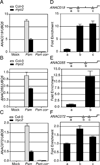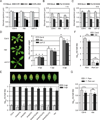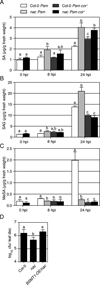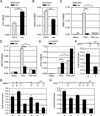Coronatine promotes Pseudomonas syringae virulence in plants by activating a signaling cascade that inhibits salicylic acid accumulation
- PMID: 22704619
- PMCID: PMC3404825
- DOI: 10.1016/j.chom.2012.04.014
Coronatine promotes Pseudomonas syringae virulence in plants by activating a signaling cascade that inhibits salicylic acid accumulation
Abstract
Phytopathogens can manipulate plant hormone signaling to access nutrients and counteract defense responses. Pseudomonas syringae produces coronatine, a toxin that mimics the plant hormone jasmonic acid isoleucine and promotes opening of stomata for bacterial entry, bacterial growth in the apoplast, systemic susceptibility, and disease symptoms. We examined the mechanisms underlying coronatine-mediated virulence and show that coronatine activates three homologous NAC transcription factor (TF) genes, ANAC019, ANAC055, and ANAC072, through direct activity of the TF, MYC2. Genetic characterization of NAC TF mutants demonstrates that these TFs mediate coronatine-induced stomatal reopening and bacterial propagation in both local and systemic tissues by inhibiting the accumulation of the key plant immune signal salicylic acid (SA). These NAC TFs exert this inhibitory effect by repressing ICS1 and activating BSMT1, genes involved in SA biosynthesis and metabolism, respectively. Thus, a signaling cascade by which coronatine confers its multiple virulence activities has been elucidated.
Copyright © 2012 Elsevier Inc. All rights reserved.
Figures






References
-
- Block A, Schmelz E, Jones JB, Klee HJ. Coronatine and salicylic acid: the battle between Arabidopsis and Pseudomonas for phytohormone control. Mol Plant Pathol. 2005;6:79–83. - PubMed
-
- Bostock RM. Signal crosstalk and induced resistance: straddling the line between cost and benefit. Annual review of phytopathology. 2005;43:545–580. - PubMed
-
- Brooks DM, Bender CL, Kunkel BN. The Pseudomonas syringae phytotoxin coronatine promotes virulence by overcoming salicylic acid-dependent defences in Arabidopsis thaliana. Mol Plant Pathol. 2005;6:629–639. - PubMed
-
- Brooks DM, Hernandez-Guzman G, Kloek AP, Alarcon-Chaidez F, Sreedharan A, Rangaswamy V, Penaloza-Vazquez A, Bender CL, Kunkel BN. Identification and characterization of a well-defined series of coronatine biosynthetic mutants of Pseudomonas syringae pv. tomato DC3000. Mol Plant Microbe Interact. 2004;17:162–174. - PubMed
-
- Browse J. Jasmonate passes muster: a receptor and targets for the defense hormone. Annu Rev Plant Biol. 2009;60:183–205. - PubMed
Publication types
MeSH terms
Substances
Grants and funding
LinkOut - more resources
Full Text Sources
Other Literature Sources
Molecular Biology Databases
Miscellaneous

